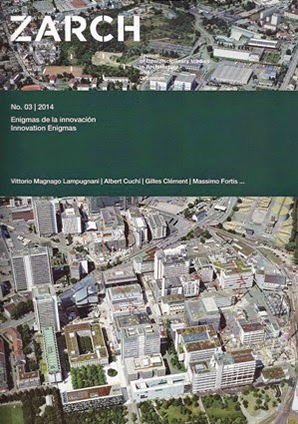Innovate or domesticate. Projects between humans, animals, plants and machines
DOI:
https://doi.org/10.26754/ojs_zarch/zarch.201439305Keywords:
Biomorphology, fluids, geometry, materials, building’s facilitiesAbstract
All animals from the areas affected by the tsunami disaster in Thailand in 2013 survived, except those that were domesticated. If we connect innovation with the term “de nuo” or “crecere”, as “novus” or “creare” for moving humanity forward, the link between wild animals and plants and environment will be a way of the survival of architectural world too. A technological advance toward the fluid origins of the living beings undoes shapes and affects building skin by a cohesive stability which responds to the energy used for manufacturing materials and taking advantage of atmospheric forces. Buildings respond to those forces simulating the behaviour of the environment by using software instead of doing it by instinct as wild animals. First at all, parametrics programming like Grasshopper allow for using complex geometrical and structural languages which are close to animal adaptations to dense flows; secondly, thermodinamics programming like Sinda/Fluint provide chemical process for manufacturinf new phase-change materials such as the mithological origins of acquatic plants; and, finally, network systems like Revit allowing full integration of structures, electrical installations and finishing such as the circulatory systems of the human body. To act like a fish is neccesary to apply the conditions of the environment for its own biological composition as the fish does, instead of having only its shape.
Downloads
References
AALTO, Alvar. “La trucha y el torrente”, Arquitectura, Madrid, (1993) nº especial 294.
BARTHES, Roland. 1998. “Flor de sangre”. En Michelet. México D.F: Fondo de Cultura Económica.
DILLER & SCOFFIDIO, Blur. http://www.dsrny.com/#/projects/blur-building
ITO, Toyo. “Tarzanes entre los bosques”. En 2G, Barcelona, Gustavo Gili, 2001.
KIRK, G.S.; RAVEN, J.E.; SCHOFIELD, M. Los filósofos presocráticos. Historia crítica con selección de textos. Madrid, Editorial Gredos, S.A. Trad. Jesús García Fernández, 1987.
KLEE, Paul. Notebooks, Vol 1: The Thinking Eye. Londres, Jürg Spiller, Lund Humphries. Trad. Heinz Norden, 1973.
LE CORBUSIER. La casa degli uomini. Milán, Editorial Jaca Book spa, 1985.
LÉVI-STRAUSS, Claude. Mitologícas 1: Lo crudo y lo cocido. México, D.F., Fondo de Cultura Económica, 1996.
LYNN, Greg. “Differential Gravities”. En Folds, Bodies and Colleted Essays. Bruselas, Books-byArchitects, La lettre volée, 1998.
MCHARG, Ian L. Design with Nature. Nueva York, The American Museum of Natural History, Double/Natural History Press, Doubleday & Company, Inc., 1971
MELVILLE, Herman. Moby Dick o la ballena blanca. Madrid, Alfaguara. Trad. Juan Gómez Casas, 1997.
MICHELET, Jules. El mar. Madrid, Colección Amura, Miraguano Editores, 1992.
NIETZSCHE, Friedrich. Escritos sobre retórica. Madrid, Editorial Trotta. Ed. y trad. Luis Enrique de Santiago Guervós, 2000.
SLOTERDIJK, Peter. Normas para el parque humano. Madrid, Siruela editorial, 2000.
VERGER, Pierre. Ewé.The use of plants in Yoruba Society. Sao Paulo, Companhia das Letras, 1995.
VINCI, Leonardo da. Cuadernos de notas. Madrid, Edimat libros. Trad. José Luis Velaz, 1999.





